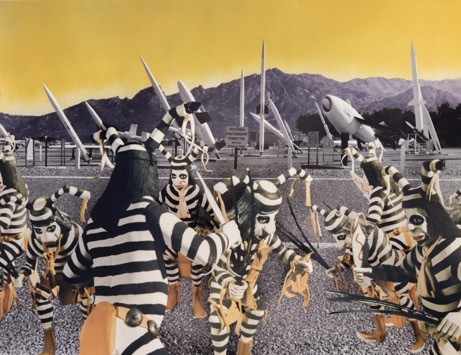
In "Koshare/Tewa Ritual Clowns, Missile Park, White Sands Missile Range, New Mexico," Nagatani warns us of the social
boundaries we have transgressed with weapons. From Nuclear Enchantments 1989-1991
The Andrew Smith Gallery is pleased to announce that we are the exclusive agents for the work of Patrick Nagatani, Sensei (1945-2017). Over a 40-year career Nagatani created a diverse body of work that pushed the contours of photography. His pioneering use of narrative tableau photography began in the 1980s. Invited to use the 20x24” Polaroid and collaborating with the painter Andrée Tracey, they planned out the sets, painted back drops, created the models, photographed scenes or people and used their pictures as props to create tableaus for the camera “to see” (1983-1989). In these works, emphasis was on the apocalyptic moment as life begins to fly apart. Here Nagatani was not only a creator but also the director.
Andrew Smith Gallery began working with Nagatani in 1987 on his arrival in New Mexico. Over thirty years we had numerous exhibitions and presented his work at national and international art fairs. it is our honor to represent his work.
Patrick Nagatani was born in Chicago and raised and educated in Los Angeles where he worked as a distinguished teacher and artist before moving to Albuquerque in 1987 to teach at the University of New Mexico. Patrick was a celebrated educator, both at Hamilton High School, Los Angeles, Loyola Marymount, Los Angeles and at the University of New Mexico. Like his mentor and professor Robert Heinecken at UCLA, Patrick’s influence on a younger generation of artists is notable.
As as a boy Nagatani discovered his love for building models, like model airplanes for example, and would utilize the master craftsmanship of his models and fabrications for four of his major bodies of work; the 20x24” Polaroid collaborations with Andrée Tracey (1983-1989), Nuclear Enchantment (1989-1991), Chromatherapy (1978-2015) and Excavations (1996-2001). The gallery has a good selection of prints from these series.
Patrick was a master craftsman, obsessive in how he approached the building of simple and complex structures. He was a director, in single tableaus, in smaller series called Novellas, and in larger series, directing the elements of each print and the prints in each series. In his final project The Race, he directed 10 collaborators, writers mostly, to create the narrative flow of his characters. He directed a photographic collaborator to create the skies through which his planes would fly, and wrote much of the text, all according to his precise designs and specifications. He was well read and equally obsessive in his research as he engaged in each project. And he was a very good poker player.
Constant themes of his work include truth in photography, the looping of time back on itself, magic realism, visual joy, apocalyptic moments, atomic bombs, photographic puns, color for healing, Japanese Internment or as Patrick called them “Concentration” camps, and the Sensei heritage. His longest working series were Tape-estries (1982-2015), the making of which was a contemplative and meditative activity, generally of Buddhist figures covered with thousands of carefully cut pieces of masking tape. And his Chromatherapy series (1978-2015), the use of light in photography led to his studying light healing as photographic expression and the creation of color prints involving light healing for various physical and emotional ailments. He himself was his own subject after he was diagnosed with colorectal cancer in 2004, a cancer that eventually took his life.

